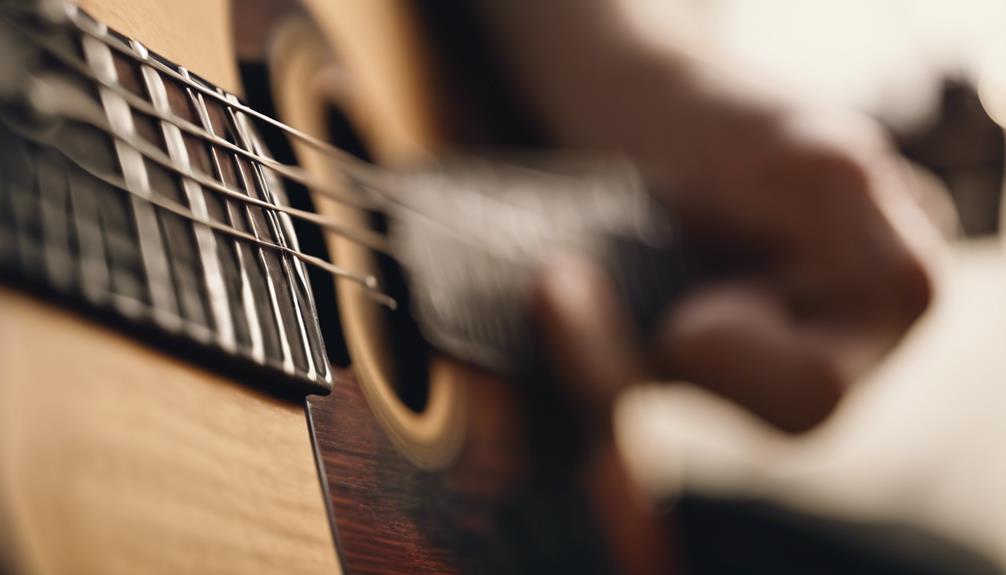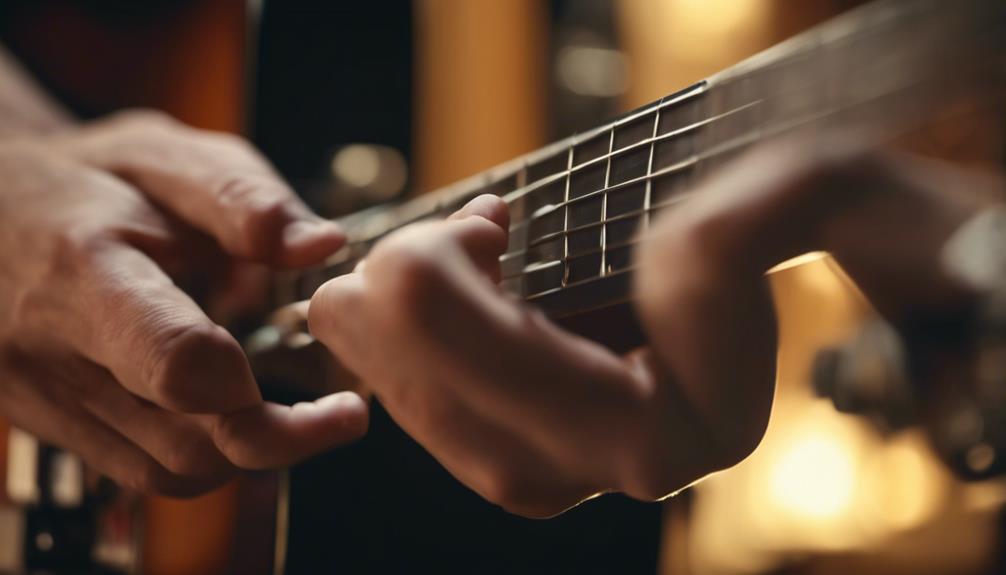When you start learning guitar, the techniques and skills you’ll acquire are essential for transforming simple notes into engaging music.
You’ll quickly realize that proper finger placement and smooth chord shifts can greatly impact your playing. But it doesn’t stop there; mastering strumming patterns and alternate picking will enhance your sound. As you grow more confident, tackling advanced techniques like sweep-picking and vibrato will add layers of complexity to your performance.
Have you ever wondered how seasoned guitarists make their solos so expressive and dynamic?
TL-DR
- Master alternate picking for efficient note playing and improved speed.
- Practice vibrato to add emotion and depth to your melodies.
- Use proper finger placement behind frets to achieve clear, precise sounds.
- Develop smooth chord transitions with metronome practice for steady rhythm.
- Incorporate palm muting techniques to enhance the rhythm and texture of your playing.
Why Learn Guitar Techniques

Learning guitar techniques is crucial because they boost your playing skills and add richness to your music. When you immerse yourself in techniques like slides, vibrato, legato, sweep-picking, and pinch harmonics, you’re not just learning fancy tricks; you’re building a toolkit that makes your guitar playing more expressive and dynamic.
Imagine being able to smoothly transition between notes, adding a seamless, gliding effect that can make a simple melody sound enchanting. Vibrato brings a note to life with its subtle pitch variations, while legato helps you connect notes fluidly, creating a more melodic sound.
Sweep-picking allows for rapid, arpeggio-based runs that can add a burst of speed and excitement to your solos, and pinch harmonics introduce squealing, high-pitched overtones that can make your playing stand out.
Mastering these techniques also helps you understand the difference between riffs and licks. Riffs are the foundation of many songs, providing memorable and recognizable hooks. Licks, on the other hand, are improvisational embellishments that add personality and flair to your solos. By incorporating both, you can create music that’s both engaging and technically impressive.
Basic Picking Techniques
To get started with enhancing your guitar skills, mastering basic picking techniques is fundamental.
When you pick up your guitar, hold the pick between your thumb and index finger. Make sure your pick hands are relaxed and use your wrist to strike the strings for clean, precise notes. This simple yet essential approach sets the foundation for all your future techniques.
Focus on developing standard strumming patterns first. Start with basic chords and practice sweeping your pick across all the strings in a smooth, even motion. The key is to produce a consistent sound with each strum. As you get comfortable, you can experiment with more complex patterns to add variety and depth to your playing.
To refine your picking further, incorporate alternate picking into your practice routine. Alternate picking involves using down and up strokes in a continuous motion. This technique not only boosts your speed but also enhances your precision.
Proper Finger Placement

Why is proper finger placement essential for every guitarist aiming to produce clean, clear notes?
Proper finger placement on the guitar guarantees that your fingertips land just behind the frets, which minimizes muted notes and buzzing. By positioning your fingers correctly, you can produce clear and precise sounds, making your playing more enjoyable and professional.
Daily practice with correct finger placement not only improves the clarity of your notes but also builds finger strength.
When you consistently place your fingertips accurately on the frets, you develop the muscle memory needed for efficient and effective playing. This also helps in reducing discomfort in your hand, allowing you to play for longer periods without strain.
Maintaining a proper finger arch is essential.
Keeping your nails trimmed short ensures that your fingertips can press the strings easily, providing better control and accuracy. By focusing on precise finger placement, you enhance your overall technique and make learning new songs and scales more manageable.
Chord Transitions
Mastering chord changes is essential for achieving smooth and seamless guitar playing. As a beginner, you might find chord shifts challenging at first, but don’t worry; consistent practice can greatly improve your accuracy and speed. Starting with simple two-chord exercises helps build confidence and proficiency.
Here are some practical tips to make your chord movements smoother:
- Practice with a metronome: Using a metronome keeps your rhythm steady and helps you maintain consistent timing, which is important for smooth shifts.
- Focus on common chord pairs: Start by practicing shifts between commonly paired chords like G to C or E to A. This will help you get used to typical movements.
- Slow it down: Don’t rush. Practice slowly at first to make sure each chord is clear and your fingers are in the correct position before speeding up.
- Use anchor fingers: Identify fingers that stay on the same string when switching chords. Keeping them in place can make shifts quicker and more efficient.
Strumming Patterns

Exploring various strumming patterns can greatly enhance your guitar playing and allow you to add a personal touch to your music. Strumming patterns vary based on the music style, which enhances both the authenticity and fluidity of your playing. If you’re just starting out, begin with basic downstroke patterns. These are simpler and will help you get the feel of maintaining a steady rhythm.
Once you’re comfortable with downstrokes, you can gradually introduce upstrokes to create rhythmic variations. Upstrokes add a layer of complexity and can make your playing sound more dynamic. Don’t be afraid to experiment with different rhythms and patterns; this experimentation will help you develop a unique playing style.
Mastering strumming patterns is essential for playing various songs and genres effectively. Whether you’re aiming to strum along to a folk song or add a percussive element to a rock track, having a variety of strumming techniques in your arsenal will serve you well.
Fingerpicking Basics
Fingerpicking involves plucking individual strings with your fingers, adding a rich texture and complexity to your guitar playing. This technique is essential in genres like folk, blues, and classical music.
To get started with fingerpicking, you’ll need to assign specific fingers to certain strings. Typically, your thumb handles the low E, A, and D strings, while your index, middle, and ring fingers take care of the G, B, and high E strings, respectively.
Mastering fingerpicking requires dedication and practice, focusing on improving your finger dexterity and coordination. Here’s a simple guide to get you started:
- Thumb Work: Practice plucking the bass strings (E, A, D) with your thumb, ensuring each note sounds clean and distinct.
- Finger Assignment: Use your index, middle, and ring fingers to pluck the G, B, and high E strings. Stick to this assignment to develop a consistent plucking technique.
- Alternating Patterns: Start with basic patterns, such as alternating between thumb and fingers, to build your muscle memory.
- Slow Practice: Play slowly and focus on accuracy. Speed will come naturally as your finger dexterity improves.
Hammer-ons and Pull-offs

To master hammer-ons and pull-offs, you’ll need to focus on proper finger placement. These techniques can greatly boost your speed and fluidity on the guitar.
Practicing them regularly will also strengthen your fingers and enhance your overall dexterity.
Proper Finger Placement
Mastering proper finger placement is essential for executing hammer-ons and pull-offs smoothly and efficiently. When you place your fingertips just behind the frets, it helps prevent muted notes, buzz, and discomfort. Maintaining a proper finger arch ensures clear and clean note playing, which is vital for techniques like hammer-ons and pull-offs.
Here are some key points to remember:
- Fingertip Placement: Always aim to place your fingertips just behind the fret. This will give you a cleaner sound and reduce the risk of buzzing or muted notes.
- Finger Arch: Keep your fingers arched, not flat, to maintain proper control and precision. This positioning is essential for executing hammer-ons and pull-offs effectively.
- Strength and Precision: Regular practice of scales and chords can build the necessary finger strength and precision. Strong fingers will help you perform these techniques effortlessly.
- Multiple Notes: Hammer-ons and pull-offs allow you to play multiple notes quickly, adding fluidity and expressiveness to your playing. Proper finger placement ensures you hit each note cleanly.
Speed and Fluidity
How can you achieve lightning-fast changes and seamless fluidity in your playing? The answer lies in mastering hammer-ons and pull-offs. These techniques are pivotal for creating smooth and connected melodies, especially during solos.
Hammer-ons involve tapping a fretting finger onto a string to produce a note without picking, while pull-offs involve lifting a finger off a fretted note to produce a lower pitch, again without picking. Both techniques minimize the need for constant picking, allowing you to play faster and more fluidly.
To practice hammer-ons, start by picking a note, then quickly tap another finger onto a higher fret on the same string. This action should produce a clear, ringing note. For pull-offs, fret a note and then lift your finger off sharply to let the lower note sound. Consistency and clarity in the notes are key, so focus on even pressure and timing.
Regularly practicing these techniques will greatly improve your speed and agility. Start slow to ensure accuracy, then gradually increase your speed. Incorporate hammer-ons and pull-offs into your daily practice routine, and you’ll notice a marked improvement in your overall guitar playing fluidity.
Alternate Picking
When you incorporate alternate picking into your guitar practice, you’ll notice a remarkable boost in your speed and accuracy. This technique involves alternating between downstrokes and upstrokes, which helps you play notes more efficiently and smoothly.
By regularly practicing alternate picking exercises, you’ll enhance your dexterity and coordination, essential skills for any guitarist aiming to play fast-paced solos and intricate melodies.
To master alternate picking, focus on the following key aspects:
- Start Slow: Begin with a slow tempo to make sure you’re correctly alternating between downstrokes and upstrokes. Gradually increase the speed as you become more comfortable.
- Use a Metronome: Practicing with a metronome helps you maintain a consistent pace and improves your timing, which is vital for developing speed and accuracy.
- Isolate Hands: Spend time working on your picking hand separately to build muscle memory and coordination. Then, combine it with your fretting hand for complete mastery.
- Practice Scales: Running through scales using alternate picking can greatly enhance your dexterity and help you familiarize yourself with different finger positions.
Incorporating these tips into your practice routine will lead to noticeable improvements in your guitar playing skills.
Vibrato Techniques

Vibrato is a powerful technique that adds emotion and depth to your guitar playing by slightly varying the pitch of a note. By mastering vibrato, you can make even the simplest melodies sound more expressive and engaging.
To execute vibrato, use your fretting hand to gently bend the string up and down. This creates a subtle pitch fluctuation that breathes life into your notes.
Different guitarists have their own unique styles of vibrato. Some prefer a subtle, narrow vibrato, while others go for a wide, dramatic effect. Experiment with different speeds and widths to find what suits your musical style. Remember, the key is control—too much or too little can make it sound unnatural.
For those with guitars equipped with a whammy bar, you can also achieve vibrato by lightly pressing and releasing the bar. This offers a different type of pitch fluctuation and can be particularly effective in rock and metal genres.
Mastering vibrato not only enhances single note melodies but also adds a personal touch to your playing. It’s one of those techniques that, when done right, can truly set you apart as a guitarist.
Barre Chords
After mastering vibrato to add expressiveness to your playing, it’s time to focus on barre chords, which are essential for achieving versatility and range on the guitar. Barre chords involve using one finger, typically your index finger, to press down multiple strings across the fretboard, allowing you to play chords in various positions.
Mastering barre chords grants access to a wide range of chord voicings and keys, making them vital for any guitarist aiming for proficiency.
Here’s what you need to focus on:
- Finger Placement: Proper finger placement is vital. Make sure your index finger is straight and presses down firmly on all the strings. Your thumb should be positioned behind the neck for support.
- Practice: Consistent practice helps build the strength and dexterity needed for barre chords. Start slowly and gradually increase speed as you become more comfortable.
- Chord Shapes: Familiarize yourself with the major and minor barre chord shapes. These shapes can be moved up and down the neck to play different chords.
- Persistence: Barre chords can be challenging initially, but persistence is key. Don’t get discouraged if you don’t get it right away; keep practicing.
Palm Muting

When practicing palm muting, start by focusing on proper hand positioning to achieve that perfect muted sound.
Next, work on controlling the dynamics to vary your playing’s intensity and texture.
Proper Hand Positioning
Many guitarists find that proper hand positioning is key to mastering the palm muting technique and achieving a dynamic, percussive sound. Palm muting involves lightly resting the side of your palm on the strings near the bridge while playing. This positioning allows you to dampen the strings just enough to create a muted effect, adding a rhythmic and percussive quality to your music.
To get started with palm muting and guarantee proper hand positioning, follow these steps:
- Place your palm correctly: Rest the fleshy part of your palm lightly on the strings close to the bridge. Too far from the bridge, and you’ll choke the notes; too close, and the muting effect will be minimal.
- Adjust pressure: Apply just enough pressure to mute the strings without completely silencing them. This balance is essential for achieving that signature percussive sound.
- Experiment with picking: Combine different picking techniques with palm muting to explore various tonal possibilities. Alternate picking and downstrokes can yield distinct textures.
- Practice with scales and riffs: Integrate palm muting into your practice routines by using scales and riffs. This will help you build muscle memory and improve your overall technique.
Muting Dynamics Control
Understanding muting dynamics control in palm muting is essential for adding depth and texture to your guitar playing. Palm muting involves lightly resting your palm on the strings near the bridge while you play, creating a muted, percussive sound. This technique is widely used in rock, metal, country, and pop music to add dynamics and rhythmic variation to your performance.
Palm muting helps you control the sustain and volume of your notes, allowing for a more controlled and punchy sound. By adjusting the pressure and position of your palm on the strings, you can vary the degree of muting to achieve different tonal effects. Light pressure results in a softer, more open sound, while firmer pressure produces a tighter, more muted tone.
Mastering palm muting is essential for achieving a tight and punchy sound in various guitar styles. Experiment with different levels of pressure and palm placement to find the sweet spot that works best for you.
Common Rhythmic Patterns
One of the most effective ways to elevate your palm muting technique is by mastering common rhythmic patterns that form the backbone of many popular songs. Palm muting is essential for creating a tight, controlled, and percussive sound that enhances the rhythm and groove of your playing.
Here are four common rhythmic patterns to help you get started:
- Eighth-Note Chugs: Alternate between muted and unmuted notes on every eighth note. This creates a driving, percussive rhythm often found in rock and metal.
- Sixteenth-Note Gallops: Play three quick sixteenth notes followed by a rest, mimicking a galloping horse. This pattern adds intensity and dynamics to your playing.
- Syncopated Mutes: Introduce syncopation by muting on the off-beats. This adds a funky, unpredictable twist to your rhythm, making it more engaging.
- Staccato Strums: Use short, muted strums to produce a choppy, rhythmic feel. This technique is great for adding texture and variation to your music.
Bends and Slides
When you master bends and slides, you’ll infuse your guitar playing with a level of expressiveness that captivates any audience. String bending involves raising the pitch by pushing or pulling the string. This technique adds emotion and flair to your solos, making each note feel more alive and dynamic.
Slides, on the other hand, require moving a fretted note up or down the fretboard, allowing for smooth shifts between notes and adding an expressive touch to your playing.
Both bends and slides are essential techniques that can greatly enhance the expressiveness and dynamics of your guitar playing. They’re widely used in various genres, including rock, blues, and country music. When you incorporate these techniques into your repertoire, you’ll find your solos becoming more unique and personal.
Mastering bends and slides is more than just a technical skill; it’s about developing your ability to convey emotion through your instrument. Take the time to practice these techniques diligently. Experiment with different styles and contexts to see how bends and slides can transform your playing.
Advanced Techniques Overview

To take your guitar playing to the next level, you can master sweep picking, tapping, and legato techniques. These techniques will allow you to play faster, more fluid solos and add intricate details to your music.
Sweep Picking Mastery
Ever wondered how guitarists achieve such fluidity and speed in their solos? Sweep picking is your answer. This advanced technique allows you to play arpeggios with remarkable fluidity. By smoothly brushing your pick across multiple strings in a single motion, you can create a cascading effect that’s both mesmerizing and technically impressive. However, mastering sweep picking requires precise coordination between your picking hand and fretting hand.
Here are four key steps to help you master sweep picking:
- Start Slow: Begin by practicing arpeggios at a slow tempo. Focus on smooth handoffs between each string to guarantee clarity.
- Use Economy of Motion: Minimize the movement of your picking hand. The less distance your pick travels, the faster and smoother you’ll play.
- Synchronize Hands: Your fretting hand and picking hand must move in perfect harmony. Practice exercises that emphasize this coordination.
- Gradually Increase Speed: Once you’ve mastered the basics at a slow tempo, incrementally increase the speed while maintaining accuracy.
Sweep picking is a staple in genres like metal and neoclassical music for its dynamic flair. By dedicating time to these steps, you’ll elevate your technical skills and add a powerful tool to your guitar arsenal.
Tapping and Legato
Explore the world of advanced guitar techniques with tapping and legato, where speed and fluidity reign supreme. Tapping involves using your fingers to tap directly on the fretboard, allowing for quick and intricate note production. This technique demands precise finger coordination and control to execute complex patterns effectively. You’ll often see advanced guitarists using tapping to add flair and speed to their solos, creating mind-blowing runs that captivate audiences.
Legato, on the other hand, focuses on playing smooth and connected notes without rearticulating each one. This technique relies heavily on hammer-ons and pull-offs to create seamless shifts between notes. Mastering legato requires you to develop strong finger coordination to maintain fluidity and clarity in your playing. By combining hammer-ons and pull-offs, you can achieve a flowing sound that feels almost effortless.
When you integrate both tapping and legato in your solos, you access a new level of expressiveness and technical prowess. The fusion of these techniques allows you to create fast, fluid phrases that showcase your skill and creativity.
Hybrid Picking Techniques
Building on the fluidity of tapping and legato, hybrid picking introduces a blend of pick and fingers to elevate your versatility and control. By incorporating both picking and finger techniques, you can seamlessly shift between intricate melodies and complex rhythms. This method allows for faster note changes and dynamic control, making your playing style more expressive and adaptable.
To master hybrid picking, you’ll need to focus on coordination and practice. Here are four key aspects to help you get started:
- Finger Independence: Develop independence between your picking fingers (usually the middle and ring fingers) and the pick. This separation is essential for executing complex patterns.
- String Skipping: Practice skipping strings with your pick while your fingers pluck other strings. This will enhance your ability to play intricate melodies across various string sets.
- Dynamic Control: Use your fingers to vary the attack on the strings, allowing for softer or more aggressive notes. This adds a dynamic range to your playing.
- Speed and Precision: Start slow to guarantee accuracy, then gradually increase your speed. Consistent practice will improve both your speed and precision.
Next up, learn about guitar picking techniques in this guide.
